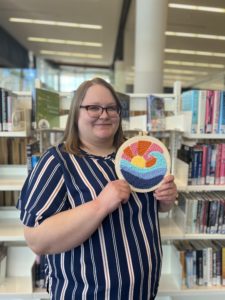Arch-conspirator by Veronica Roth
In ARCH-CONSPIRATOR, Veronica Roth puts a futuristic spin on Sophocles’ Antigone. Roth transfers the ancient Greek tragedy to the last city on Earth, which stands as the lone haven in a desolate wasteland created by humanity.
The city is ruled over by Antigone’s uncle Kreon, the High Commander, a militant man obsessed with order and maintaining the status quo. Kreon took the throne after a riot – that he instigated – killed the former High Commander, Antigone’s father Oedipus.
Antigone and her siblings are set apart from the population not because their father was deposed and replaced as High Commander, but because their parents chose to have them independently. In this future, children are created using the ichor stored in the Archive, a gene bank containing the cells from generations of the dead.
It is considered unnatural to have biological children. Those children are looked down upon as being soulless, because the soul lives in a person’s ichor and is passed down to the next generation when new life is created.
Humanity is kept in check by Kreon’s marshal rule as well as this strict pseudo-religious dedication to humanity’s future.
After taking the throne, Kreon allowed Antigone and her siblings to live in the High Commander’s residence with his family. Over the years, the four of them integrated themselves into these new lives with varying levels of success.
Antigone grew stoic and stubborn. She has since been unwillingly betrothed to Kreon’s son, Haemon.
Antigone’s twin, Polyneikes, has chafed against his uncle’s rule. He has joined a group of revolutionaries from the city who seek to overthrow Kreon.
Ismene, their sister, abides by Kreon’s rules, for the most part. She is quieter and meeker than the twins, but she does rebel in her own ways.
Their brother, Eteocles, has assimilated almost completely into the new High Commander’s regime. He has become a member of Kreon’s personal guard.
As the book opens, Antigone joins Polyneikes at a café in the city. Her brother alludes to dangerous plans he has for that evening. He ends their conversation by giving Antigone and Extractor – the metal instrument used to harvest ichor from the dead. Polyneikes makes Antigone promise that she will use it on him if things go badly.
Late that night, Antigone and Ismene hear a fight taking place in the courtyard of the High Commander’s residence. When they arrive at the scene, they find Polyneikes and Eteocles, who have shot and killed one another. One brother on his way to kill Kreon and the other protecting him.
Kreon labels Polyneikes a traitor and decrees that his body is not to be touched – or Extracted for the Archive – as a warning against insurrection. To honor her brother’s wishes, Antigone has twenty-four hours from his death to get to him and use the stolen Extractor.
Veronica Roth’s novella is a quick but intense read. She narrates chapters from many of her key characters, allowing readers a glimpse at the inner turmoil faced by each of them. Alongside this story of revenge and familial love, ARCH-CONSPIRATOR also offers a variety of perspectives on life at the end of the world.
Book review by Alyssa Berry, Technical Services Librarian


